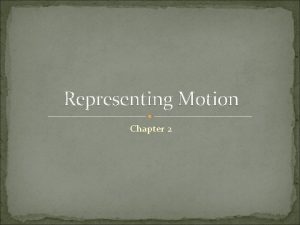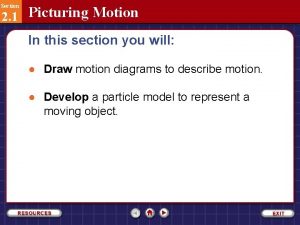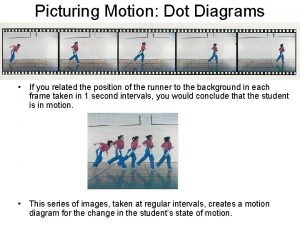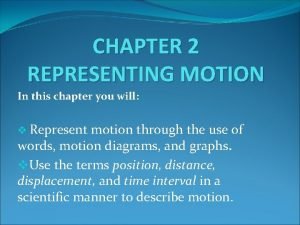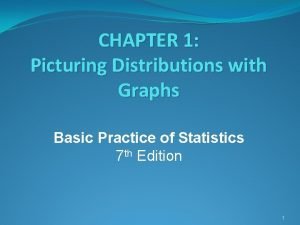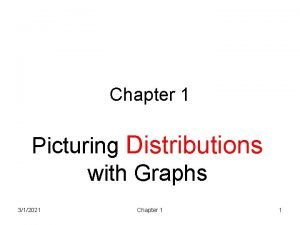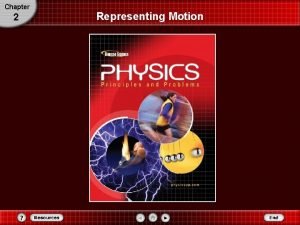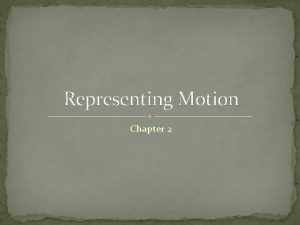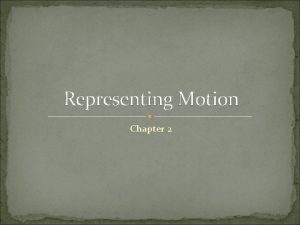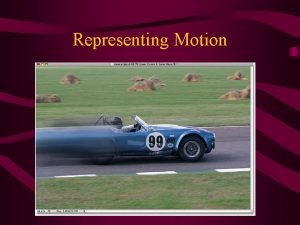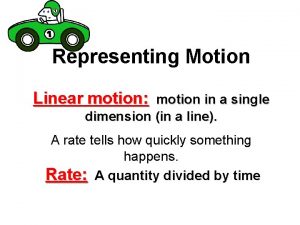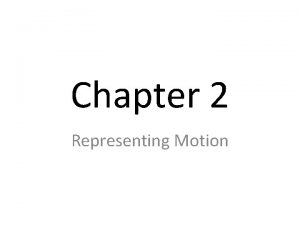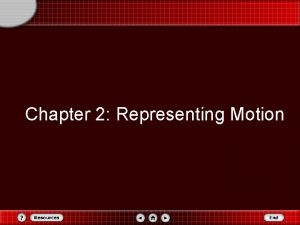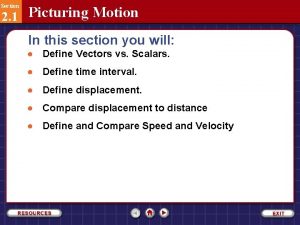REPRESENTING MOTION Chapter 2 2 1 Picturing Motion












- Slides: 12

REPRESENTING MOTION Chapter 2

2. 1 Picturing Motion � Position changes when object is in motion � Straight � line, arc, circle, back and forth … Focus on straight line

Motion Diagrams � Represents position of object at equal time distances . . � � Particle model shows object as a dot Distance between dots shows equal time distances

2. 2 Where and When? � � � Measurements define a coordinate system Position – separation between object and origin Connecting origin with object’s position using arrow � Shows distance from origin � Direction of motion in direction of arrow � Can you have a negative position? Distance?

Vectors and Scalars � Vectors – quantities that require both direction and magnitude � Examples � ? Scalar – quantities that require only magnitude � Temperature, � time, distance Says nothing about units

Vectors � Giving directions � Travel 3. 7 km east to get to the store � Travel 1. 5 km east to get from the store to work � How far from the origin? 3. 7 km east + 1. 5 km east = 5. 2 km east � Represent it with a picture � Resultant – vector that represents the sum of the other vectors � Points from tail of first vector to tip of second vector

Time Interval & Displacement � � Time interval (Dt) is the difference between 2 times Dt = tf – ti � Sometimes t 0 � is used Changes in position called Displacement (Dd) � Vector quantity Sometimes indicated with (+ or -) signs � Dd = d f – di Sometimes d 0 is used � No indication of path taken by object

Dt and Dd . . Direction? ? Starting position? ? . . .

2. 3 Position-Time Graphs Intersections? Horizontal line? Positive vs. Negative slope? � Tells the same story as the motion diagram � Includes information about direction and starting position � Instantaneous position � Specific position at specific time

2. 4 How Fast? � � Rate of change in position is Average Velocity Vector quantity Slope of positiontime graph Absolute value of slope is average speed

Velocity � � Velocity at a specific instant is instantaneous velocity Instantaneous velocity different than average velocity � Average velocity is entire displacement divided by entire time interval � Avg v = Dd/Dt �d = avg v*t + di

Lab � Chapter 2, pgs 48 -49 � With multiple buggies
 Chapter 2 representing motion
Chapter 2 representing motion Picturing motion
Picturing motion Dot diagram motion
Dot diagram motion Physics chapter 2 representing motion assessment answers
Physics chapter 2 representing motion assessment answers Chapter 2 representing motion
Chapter 2 representing motion Elementary statistics picturing the world 6th edition
Elementary statistics picturing the world 6th edition Elementary statistics picturing the world 6th edition
Elementary statistics picturing the world 6th edition Picturing distributions with graphs
Picturing distributions with graphs Picturing distributions with graphs
Picturing distributions with graphs Elementary statistics 6th edition
Elementary statistics 6th edition Representing motion
Representing motion Chapter 2 motion section 1 describing motion answer key
Chapter 2 motion section 1 describing motion answer key Measuring motion
Measuring motion
